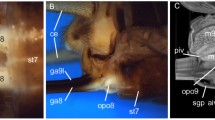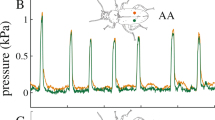Summary
-
1.
Pulsing and streaming of haemolymph in the heart, aorta and perineural sinus of unrestrained, unnarcotizedPapilio machaon L. (Lepidoptera, Papilionidae) were studied. The interrelationships between heart activity, abdominal movements and activity of thoracic pulsatile organs in haemolymph transport were examined and the indirect effects of these activities on tracheal ventilation of the thorax evaluated.
-
2.
A thermistor technique was developed to record haemolymph movements by their convective and conductive cooling effects at the cuticular surface of insects. In addition, the direction of pulses and of haemolymph flow was determined from temperature measurements, utilizing the temperature gradient along the body axis of basking butterflies.
-
3.
The direction of heart peristalsis changes periodically and is coordinated with abdominal length changes which were recorded using a photocell. Abdominal expansion is accompanied first by a pause and subsequently by reverse beating of the heart. Abdominal expansion may play a leading role in backward haemolymph transport and cause periodic ventral haemolymph backflow through the perineural sinus. Such backflow is most vigorous during heart pauses. The rhythmic undulatory movements of the ventral diaphragm give rise to only slight thermal convective effects.
-
4.
The oscillation of haemolymph between thorax and abdomen is documented on the basis of changes in thermal conduction of the thorax. The significance of periodic haemolymph volume reduction in the thorax for tracheal ventilation is discussed with special regard to the role of heartbeat reversal.
-
5.
During the forward heart pulse periods the abdomen performs volleylike ventilatory movements. These do not cause streaming of haemolymph in the thoracic haemocoel, which at this time is shut off from the abdominal haemocoel by a valve mechanism. This valve, situated in the anterior abdomen, was examined histologically and by scanning electron microscopy.
-
6.
The activity of the lateral thoracic pulsatile organs is regularly interrupted by pauses which occur most frequently during the second half of the heart's forward pulse period. The function of the pulsatile organs is discussed in relation to changing thoracic haemolymph content.
Similar content being viewed by others
Abbreviations
- PNS :
-
perineural sinus
- PO :
-
accessory thoracic pulsatile organ
- C-method :
-
conduction-convection measurement
- T-method :
-
temperature measurement
References
Bayer, R.: Untersuchungen am Kreislaufsystem der Wanderheuschrecke (Locusta migratoria migratorioides R. et F., Orthopteroidea) mit besonderer Berücksichtigung des Blutdruckes. Z. Vergl. Physiol.58, 76–135 (1968)
Beckel, W.E.: The morphology, histology and physiology of the spiracular regulatory apparatus ofHyalophora cecropia (L.) (Lepidoptera). Proc. 10th Int. Congr. Entomol.2, 87–115 (1958)
Brocher, F.: Les organes pulsatiles méso- et métatergaux des Lépidoptères. Archs. Zool. Exp. Gen.58, 149–171 (1919)
Brocher, F.: Étude éxpérimentale sur le fonctionnement du vaisseau dorsal et sur la circulation du sang chez les insectes. III. LeSphinx convolvuli. Archs. Zool. Exp. Gen.60, 1–45 (1920)
Brocher, F.: Le méchanisme de la respiration et celui de la circulation du sang chez les insectes. Archs. Zool. Exp. Gen.74, 25–32 (1931)
Buddenbrock, W. von: Blut und Herz. In: Vergleichende Physiologie, Vol. VI, pp. 1–466. Basel, Stuttgart: Birkhäuser 1967
Carus, C.G.: Nachträgliche Bemerkungen über den Blut-Umlauf in den Kerfen, insbesondere den Blut-Umlauf in vollkommenen betreffend. Isis21, 478–480 (1828)
Freudenstein, K.: Das Herz und das Cirkulationssystem der Honigbeiene (Apis mellifica L.). Z. Wiss. Zool.132, 404–475 (1928)
Gerould, J.H.: Periodic reversal of heart action in the silkworm moth and pupa. J. Morphol.48, 385–431 (1929)
Gerould, J.H.: Structure and action of the heart ofBombyx mori and other insects. Acta Zool. (Stockholm)19, 297–352 (1938)
Graber, V.: Die Insekten, Bd. 1. München: Oldenburg 1877
Heinrich, B.: Heat exchange in relation to blood flow between thorax and abdomen in bumblebees. J. Exp. Biol.64, 561–585 (1976)
Hanegan, J.L.: Control of heart rate inCecropia moths; response to thermal stimulation. J. Exp. Biol.59, 67–76 (1973)
Hessel, J.H.: A preliminary comparative anatomical study of the mesothoracic aorta of the Lepidoptera. Ann. Entomol. Soc. Am.59, 1217–1227 (1966)
Hessel, J.H.: The comparative morphology of the dorsal vessel and accessory structures of the Lepidoptera and its phylogenetic implications. Ann. Entomol. Soc. Am.62, 353–370 (1969)
Jones, J.C.: The circulatory system of insects. Springfield, Illinois: Thomas 1977
Krogh, A.: Studien über Tracheenrespiration. II. Über Gasdiffusion in den Tracheen. Pfluegers Arch. Gesamte Physiol. Menschen Tiere179, 95–120 (1920)
Lagerspetz, K., Perttunen, V.: Effect of temperature on the periodic heart beat reversal and heart rate inCorethra plumicornis (Diptera). J. Insect. Physiol.8, 621–625 (1962)
McCann, F.V.: Unique properties of the moth myocardium. Ann. N.Y. Acad. Sci.127, 84–99 (1965)
McCann, F.V.: Physiology of insect hearts. Annu. Rev. Entomol.15, 173–200 (1970)
Miller, P.L.: Respiration-aerial gas transport. In: The physiology of insecta, Vol. VI. Rockstein, M. (ed.), pp. 345–402. New York, San Francisco, London: Academic Press 1974
Miller, T.A.: Electrophysiology of the insect heart. In: The physiology of insecta. Vol. V. Rockstein, M. (ed.), pp. 169–200. New York, San Francisco, London: Academic Press 1974
Moreau, R., Lavenseau, L.: Rôle des organes pulsatiles thoraciques et du coeur pendant l'émergence et l'expansion des ailes des Lépidoptères. J. Insect Physiol.21, 1531–1534 (1975)
Plateau, F.: Recherches expérimentales sur les mouvements respiratoires des insectes. Mem. Acad. R. Belg.65, 1–219 (1884)
Queinnec, Y., Campan, M.: Influence of sexual maturation on cardiac activity and reactivity ofCalliphora vomitoria. I. Cardiac activity. J. Physiol. (Paris)70, 457–466 (1975)
Richards, A.G.: The ventral diaphragm of insects. J. Morphol.113, 17–47 (1963)
Richards, S.A.: Temperature regulation. London, Winchester: Wykeham Publications 1973
Tenney, S.M.: Observations on the physiology of the lepidopteran heart with special reference to reversal of the beat. Physiol. Comp. Oecol.3, 286–306 (1954)
Wasserthal, L.T.: Herzschlag-Umkehr bei Insekten und die Entwicklung der imaginalen Herzrhythmik. Verh. Dtsch. Zool. Ges.1974, 95–99 (1975a)
Wasserthal, L.T.: The rôle of butterfly wings in regulation of body temperature. J. Insect Physiol.21, 1921–1930 (1975b)
Wasserthal, L.T.: Heartbeat reversal and its coordination with accessory pulsatile organs and abdominal movements in Lepidoptera. Experientia32, 577–578 (1976)
Wasserthal, L.T., Wasserthal, W.: Innervation of heart and alary muscles inSphinx ligustri L. (Lepidoptera). Cell Tissue Res.184, 467–486 (1977a)
Wasserthal, L.T.: Ein zentrales Hämolymphdruckventil im Insektenkörper und seine Bedeutung für die Tracheenventilation. Verh. Dtsch. Zool. Ges.1977, 276 (1977b)
Wasserthal, L.T.: Pendelnde Hämolymphversorgung und Tracheenventilation im Schmetterlingsflügel. Verh. Dtsch. Zool. Ges.1978, 268 (1978)
Weber, H.: Grundriß der Insektenkunde. Stuttgart: Gustav Fischer Verlag 1966
Wigglesworth, V.B.: The principles of insect physiology. 7th edn. London: Capman & Hall 1972
Author information
Authors and Affiliations
Rights and permissions
About this article
Cite this article
Wasserthal, L.T. Oscillating haemolymph ‘circulation’ in the butterflyPapilio machaon L. revealed by contact thermography and photocell measurements. J Comp Physiol B 139, 145–163 (1980). https://doi.org/10.1007/BF00691029
Accepted:
Issue Date:
DOI: https://doi.org/10.1007/BF00691029




